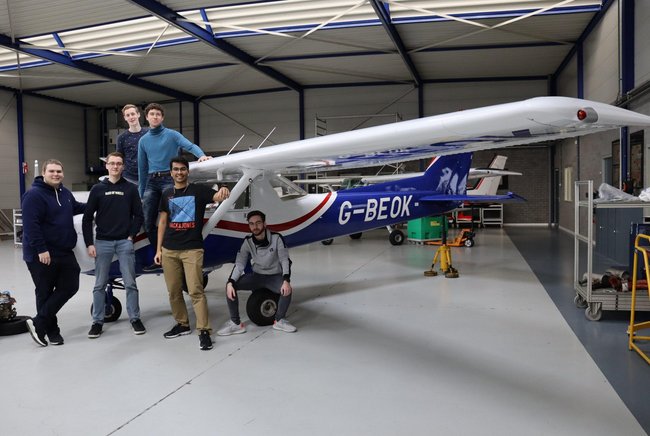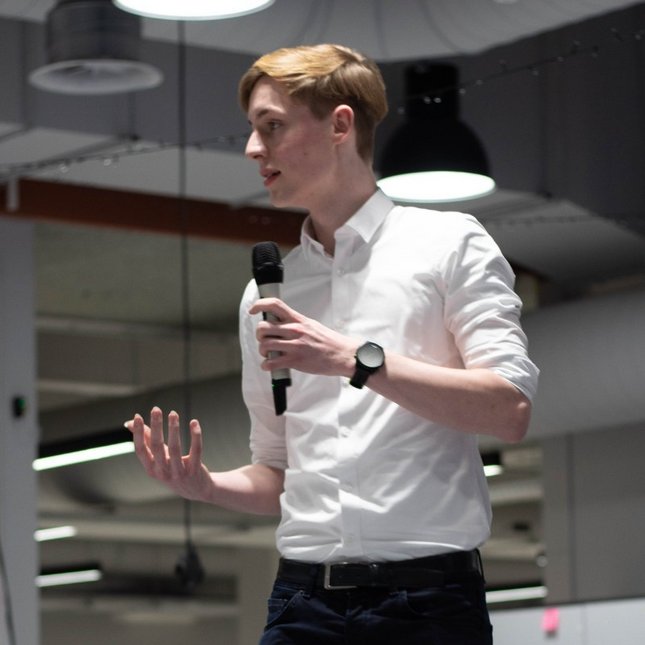First clean aircraft with electric motor ready for take-off in 2021
Student team Falcon Electric Aviation wants to offer a sustainable alternative for pleasure flights, flying lessons and business flights.

“Elon Musk also started by converting existing cars into electric vehicles. In the meantime, that has become a billion dollar company,” says Brandon van Schaik, co-founder of Falcon Electric Aviation. “We want to do that with airplanes.” Tesla is thereby a great example for the students.
“We sat down with a few friends two years ago and talked about the energy transition. All kinds of sustainable solutions are already being thought up for cars and buses, but not so much for airplanes and boats,” Van Schaik explains. “That’s why we started looking at the possibilities for airplanes.” The students soon found out that designing and certifying a new type of aircraft costs a lot of time and money. “We don’t have that time anymore. We must work towards a more sustainable world right now,” he asserts. That is why they have looked into the possibilities of converting existing aircraft.
The first converted airplane should be ready in just over six months. “We received a subsidy from the Eindhoven Metropolitan Region. With this, we were able to demonstrate the technical and financial feasibility,” says Van Schaik. Converting an actual airplane was the best way to do this according to the student. “We are working closely with Kempen Airport in Budel in order to do this. They are also extremely interested in our project.”

Flight schools
But batteries are far too heavy to fly with, aren’t they? “Yes, it probably wouldn’t work for a Boeing 747 with 200 passengers flying to America. In any case, that still requires a lot more development,” Van Schaik admits. “But it works well on shorter flights for aircraft with room for up to twenty passengers.” The first plane that the students are going to convert into an electric plane is a Cessna 150, a two-seater plane. “We have noticed that flight schools, for example, are interested in our technology. They use these small planes a lot”, he adds. “A plane is always back on the ground after an hour’s lesson. So recharging is not an issue.”
Besides the fact that this benefits the environment, it is also interesting for flight schools in terms of price. “They can recoup the conversion package costs in about four to five years,” says Van Schaik. “Because electricity is cheaper than kerosene and given that maintenance of an electric motor is much easier than an internal combustion engine.” The conversion package is expected to cost approximately €150,000. On top of that, the batteries will have to be replaced every five years or so, because they will lose their capacity over time. “But even then it is comparatively cheaper for flight schools to fly electrically,” he points out.
What’s more, the batteries do not make the aircraft larger or heavier. “An internal combustion engine weighs about 200 kilos. An electric motor with the same capacity only weighs twelve kilos. So we can use the surplus weight for batteries,” Van Schaik adds. “The interior also remains the same. Pilots can fly both the existing and the electric planes.”
How many people fly in these types of small planes? “Most people tend to think of large passenger airplanes, but about ninety percent of all planes registered in the Netherlands are actually small planes,” he states. These are used for pleasure flights, flying lessons and business flights, for instance, says Van Schaik. “You could say that people should look for alternatives to flying, but changing human behavior is very difficult. That’s why we want to offer these people a more sustainable alternative,” he states.

Hydrogen
The students want to contribute to the energy transition with their conversion package. “Innovation in aviation is very slow. The planes we are currently flying in were originally made in the 1960s. Since then, companies have only made modifications to the aircraft, but nothing has fundamentally changed,” Van Schaik notes. The students want to change that now. “If our plan for electric airplanes goes well, we also want to look at other options, such as hydrogen.”
“The development of hydrogen-powered aircraft is going to take a number of years,” he goes on. “But it could provide a sustainable alternative for longer flights with more passengers.” He explains that scaling-up will be difficult for electric aircraft. “You have to carry too many heavy batteries for a long flight. Besides that, the engine also has to be bigger. Since an electric motor works with magnets, it can’t become too big. In that case, the magnets would not work properly anymore,” he clarifies. “You can opt for several smaller engines, but then the aircraft will have to be built completely differently.” You wouldn’t be able to convert an airplane then. Whereas that is precisely the added value that Falcon has to offer,” says Van Schaik. Falcon wants to see how they can convert existing aircraft for hydrogen as well.
He concludes: “In order to make aviation more sustainable, just as is the case with road transportation, we have to create a combination of various sustainable options, such as electric and hydrogen-powered aviation. We want to show what the possibilities are and bring this to the market in the most accessible way possible.”
Source: Innovation Origins